|
Indigenous
Australians and the Snowy
The Snowy River and its hinterland have sustained humans
for thousands of years. Before European colonists went
to the region in the early 19th century, the Indigenous
Ngarigo, Walgalu and Southern Ngunnawal people lived
and interacted in the region. They fished in its waters
and hunted game in the surrounding countryside. Around
Jindabyne, the river rocks were used extensively for
tool making. Men and women had separate sacred water
holes for purification ceremonies. In the warmer months
people would travel to the high country to feast on
bogong moths.
| This
photograph taken by Charles Kerry around 1890 shows
Boona, a Ngarigo woman from the Monaro region which
surrounded the Snowy River. She was referred to
as a Queen of the Manero by whites. Although
the title did not accurately reflect Aboriginal
tribal hierarchies, it may well have indicated that
she held a significant place within her tribal group. |
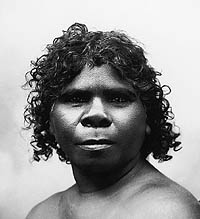
Photo: Boona of the Cooma Tribe
by Charles Kerry. Tyrrell Collection, Powerhouse
Museum. |
The
Snowy in the 19th century
From the 1820s Indigenous people were gradually dispossessed
as colonists from Europe and Asia arrived. Polish explorer
P.E. Strzelecki was among the first Europeans to explore
the area. He named Mount Kosciuszko, Australia's highest
mountain, after Tadeusz Kosciuszko (1746-1817), an engineer
and soldier. By the end of the 19th century the Ngarigo
and Wolgal population had dwindled as a result of disease,
violence and dispersal.
|
The
river took on a different significance for the
colonists who now occupied the area for grazing,
farming and gold mining. Exotic trout were introduced
from the late 1880s and within a decade the Snowy
had become renowned for its sport fishing. Most
notably, the area became associated with the emerging
national mythology of the Australian bushman,
following the publication of Banjo Paterson's
poem about the exploits of the high country stockman,
The man from Snowy River, in 1895.
This
photograph titled Glimpse on the Snowy River,
was one of several images of the river taken by
prolific commercial photographer Charles Kerry
around the time that Paterson wrote his poem.
|

Photo: Glimpse on the Snowy River
by Charles Kerry. Tyrrell Collection, Powerhouse
Museum |
A
wasted resource?
Despite its mythologisation, the Snowy River was also
regarded by many non-indigenous Australians as a wasted
resource because it flowed to the sea through country
that was already well watered. Proposals to divert the
river for irrigation and power generation were presented
from as early as the 1880s but it was not until the
1940s that the necessary resources and technological
capacity were realised with the Snowy Mountains Scheme.
The Snowy River was finally dammed twice: first at its
headwaters at Island Bend in 1965, and again downstream
at Jindabyne in 1967.
After
Lake Jindabyne was created, 99% of the river's water
was retained and diverted for power generation and irrigation.
In October 2000 however, the NSW and Victorian governments
with the Federal government, agreed to a program to
return 28% of the river's former flow by 2010.
Impact
on the environment
Activity
The Snowy Mountains Scheme has resulted in enormous
environmental upheaval and change. The impact on the
environment is a complex issue to assess. There are
at least two different points of view to consider. Read
the material below and summarise in a list the positive
and negative impacts.
Environmental
and social costs
The contradictory view of the Snowy River as both a
cherished landscape and a resource to be exploited,
has characterised white Australian attitudes towards
the river to the present day. Groups such as the Snowy
River Alliance campaigned vigorously in the 1990s to
restore more of the river's flow. They argued that with
only one percent of its original water, the ecology
of the river was collapsing.
Those who lived down stream from the Jindabyne Dam were
compelled to find alternative sources of water. These
people had been told that the Scheme would stop spring
flooding. After the damming of the Snowy, they struggled
to get enough water for domestic and commercial use.
Significantly
campaigners bolstered their arguments by emphasizing
the river's heritage significance as the 'birthplace'
of the Man from Snowy River. In 1998 they organised
a protest on the banks of the Snowy at Dalgety featuring
Tom Burlinson, the actor who had played the Man from
Snowy River in the 1980s telemovie. The river, it was
argued, was as much a 'national cultural icon' as it
was a ecological system to be restored.
|
This
‘Save the Snowy’ poster was one of many
produced by the Snowy River Alliance to publicise
the plight of the river. Through meetings, petitions,
and political lobbying they have managed to make
their case a significant issue in the press and
parliament.
Environmental
concerns were not confined to the Snowy River
in the east. Critics of the Scheme also pointed
to the waste of water that occurs through evaporation
and seepage along its route from east to west
and authority over its management shifts from
the Authority to other state bodies. Dry land
salinity in the western farnlands, resulting from
the rising salt table caused by excessive irrigation,
was another major concern.
|
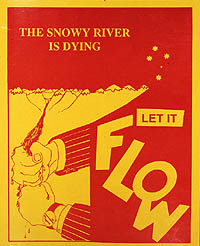
Courtesy: Snowy River Alliance
|
Environmental
and social benefits
The Snowy Mountains Scheme provides about 74% of available renewable
energy on the eastern mainland Australian electricity grid and 28% nationwide. This represents a
displacement of more than 5 million tonnes of 'greenhouse
gases' that contribute to global warming every year.
As hydro-generated energy it does not pollute the atmosphere
and as it is part of the water cycle, it is renewable.
Unlike other renewable energy sources it is easy to
store and the water can be used several times as it
passes through a series of power stations. In addition,
the Scheme's scenic lakes and reservoirs are used for
recreation by hundreds of thousands of visitors each
year.
The water diverted westward from the Snowy, Tumut and
other rivers by the Scheme, contributes to the Murrumbidgee
Irrigation Area in the dry inland of NSW. Farmlands
irrigated by the Snowy water produce millions of dollars
worth of crops every year, for the national and international
markets. Irrigation sustains dozens of agricultural
communities in this region of Australia. In 1968 an
entire town, Coleambally, was created as a result of
the new flow of water
Rhona
Morton, pictured here, and her husband Les moved to
a farm in the Coleambally area in 1964. They lived in
this caravan and a shed for 2 years while building a
house. It took several years of work before the farm
returned a profit.

Photo: courtesy L and R Morton
|
Irrigated
crops
The irrigated fruit and grain crops produced in western
NSW are worth millions of dollars annually. This photograph
shows irrigation canals at a citrus orchard in the Riverina.

Photo: Gregory Heath, courtesy CSIRO
Land and Water, Griffith Laboratory.
|
Rice
is the main summer crop in the Murray and Murrumbidgee
valleys of western NSW. Fields, like this one, remain
flooded for 4-5 months and therefore need large amounts
of irrigation water. Rice is a significant export crop.

Photo: Gregory Heath, courtesy CSIRO
Land and Water, Griffith Laboratory.
|
The
Snowy Water Inquiry
An
inquiry was set up into the flow of the Snowy and hundreds
of submissions were received locally and from further
afield. The inquiry found that restoring 30% of the
Snowy flows was not economically viable. It recommended
instead 15% along with improvements to irrigation pratices
in the west. The balance of power shifted markedly in
1999 when a local pro-river independent candidate for
the Victorian parliament, Craig Ingram, defeated the
sitting National Party member in the State election.
Along with two others he held the balance of power after
a landslide vote against Jeff Kennett’s coalition
government. Ingram’s newfound power was instrumental
in getting Victoria and NSW to commit to funding better
irrigation practices including the enclosure of canals
to stop evaporation in order to return flow to the Snowy.
The accompanying commitment to restore 28% of the river’s
flow was hailed by farmers in the east and conservationists.
The
fight was bitter because, as the Commissioner of the
Water Inquiry Robert Webster noted, restoration of flow
to the Snowy pitted three Australian icons against each
other, the river which had been immortalised by Banjo
Paterson's poem; the Snowy Mountains Hydro electric
scheme which generates clean electricity and was arguably
the seat of Australian multiculturalism; and the food
bowl of the farmlands of the Murray and the Murrumbidgee,
irrigated by additional flows from the Snowy. However
the result is evidence of the increased questioning
of dry land irrigation and dam construction in Australia
and is potentially one of Australia’s most significant
cases of environmental rehabilitation.
Activity
1. Read the following articles about the future of the
Snowy River.
Bonyhady, T. (2000) Old man icon, Sydney Morning Herald,
May 20, 6S.
Condon, M. (2000) Roaring glory, The Australian Magazine,
October 14-15, pp 16-20.
2. Visit the Snowy Mountains Hydro-electric Authority
www.snowyhydro.com.au/environment/report.pdf web-site
to download a PDF file of the document Meeting the environmental
challenge (1999).
Impact
on society
Lost places
The creation of the huge Eucumbene, Jindabyne, Blowering
and Jounama reservoirs resulted in the flooding of thousands
of hectares of land. Two whole towns, Adaminaby and
Jindabyne, and numerous farms and homesteads were inundated.
Thousands of years of Aboriginal history were also lost
beneath the waters. Both Adaminaby and Jindabyne were
rebuilt nearby as new towns that were heralded as modern
and comfortable. People were compensated by the Authority
for their losses and relocated.
| Aboriginal
people from around Tumut and the Monaro lost their
land to European colonists long before the Snowy
Mountains Scheme started. Those remaining by the
end of the 1800s were moved off to missions and
reserves. They left many objects and sites of social
and spiritual significance. Some were recorded before
land was flooded for the Scheme, others remain unknown.
These places and objects are lost to descendants
of the original inhabitants and to the country.
This 19th century Aboriginal grave near Jindabyne
was recorded by anthropologist Richard Helms in
his article 'Anthropological Notes', Journal
of Proceedings of Linnaen Society, 1895. |

Illustration of 19th
century Aboriginal grave from
Richard
Helms 'Anthropological Notes' 1895. |
| Sixty
years later Dom Rankin took this photograph of his
family home in Jindabyne with a Box Brownie camera.
It was the last time he saw his family home. When
the photograph was taken, the building had already
been sold to the Authority and was demolished shortly
afterwards. |
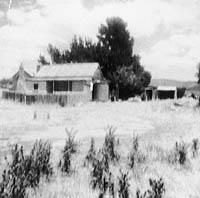
Photo: Dom Rankin
|
New
towns
Some people were happy with their compensation and the
prospect of moving to a modern town, but others grieved
at giving up their homes in the national interest.
This grief, writes historian Peter Read, is for "lost
places" and "lost roots, lost childhood or
a lost community". The new Adaminaby, located several
kilometres away from Lake Eucumbene, suffered from physical
and economic isolation. The new Jindabyne, however,
has flourished partly as a result of its proximity to
Lake Jindabyne, which provided a new identity and source
of income. (Read, 1996: 75-100)
Many
other properties across the Blowering Valley were flooded
with the construction of the Blowering and Jounama Dams
in the 1960s. These included Talbingo Station, the birthplace
of renowned Australian writer Miles Franklin. Jack Bridle's
family moved to the valley in 1848. Jack, a local historian
and poet, was born at a nearby settlement but arrived
at Blowering as a boy in 1921. After the dams were built
Jack Bridle farewelled his valley in a poem that
highlights the association of place with personal identity
and family and community history.
Snowy
Scheme kids
Thousands of children grew up around the Snowy Mountains
Scheme. Many, of course, were local children. They saw
their towns change with the development of the Scheme.
Others came to the area because one or both parents
found work there. They lived in large established towns
like Cooma or construction townships such as Cabramurra
and Eaglehawk. Many others were born on the Scheme.
The
presence of so many children changed the shape of existing
towns. Recreational facilities, schools and baby health
centres were required and were built by the Authority
or the major construction companies. At Jindabyne, for
instance, the Authority provided a school building.
At Cooma it subsidised the construction of a public
pool.
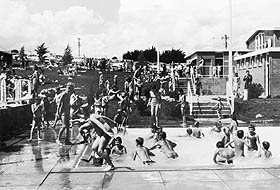
Cooma public pool. Photo: Bayram
Ali (Powerhouse Museum Collection)
|
The
Snowy was a unique place to grow up because of the climate,
the social mix and the mobility of many of the families.
Children learnt to ski for fun and out of necessity.
The photograph below shows boys practising ski jumping
at Cabramurra, in the late 1950s. Cabramurra is the
highest town in Australia and during the years of the
Scheme it hosted many skiing events.
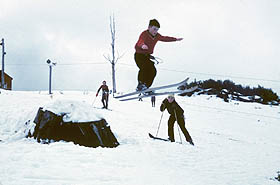
Photo: Bayram Ali (Powerhouse Museum
Collection) |
Some
immigrant workers brought children with them from overseas.
While they often went through the difficult experience
of being different from local children in language,
dress and custom, the presence of so many different
cultures also helped overcome such problems. The photograph
below shows boys at Eaglehawk standing with a soccer
ball on the township's playing fields. An organised
game for workers proceeds in the background. Soccer
was a relatively uncommon sport in regional NSW in the
1950s but it was popular with migrant workers and their
children.

Photo: Bayram Ali (Powerhouse Museum
Collection) |
Kalev
Tarmo, son of an Estonian worker, lived high in the
mountains at Happy Jacks village. He commented on the
effect of the experience on growing-up:
We
became different to a lot of other children. We found
we could be on our own longer and be more independent,
and the friendships seemed to be more binding. We
subscribed to a lot of periodicals and radio was a
big thing. (McHugh, 1989: 200)
Australian-born
Chris Griffiths recalled his childhood at Tumut:
We didn't really think it was any different from anywhere
else... In winter you'd go visiting the other houses...
their parents might be French so you'd have French
tucker. The next lot might be German and they'd have
all these knick-knacks lyin' around… that's what
was interesting. (McHugh, 1989: 201)
Families
often moved from one construction township to another
as projects were finished and others commenced. The
settlements were often divided by work status into precincts.
In Cooma, for example, children of wages or trades personnel
went to Cooma East school, while the children of salaried
or professional staff went to Cooma North school.
A
Multicultural workforce
When the Scheme began in 1949, there was a shortage
of scientific and engineering skills to meet the challenges
posed by the project. A massive national and international
recruitment programme was carried out. Migrants from
many countries with skills in surveying, tunnelling,
geology, hydrology, and transmission-line installation,
came to Australia to work on the Scheme.
Australians
worked alongside people from over 30 different countries
like Great Britain, Germany, Czechoslovakia, Italy and
Norway.
All
strata of society were represented, from the inhabitants
of historic centres of culture like Vienna and Budapest,
Berlin and Paris, to those living in remote villages
in the Balkans and Ukraine in conditions not far removed
from feudal times. (Raymond: 1999: 60)
The
Snowy Mountains Scheme is often portrayed as the start
of multiculturalism in Australia because of the intensity
and success of its cultural mix. This claim tends to
obscure a long history of cultural diversity across
Australia. From Broome in the north of Western Australia
to Melbourne in the south east of the continent, there
were many examples of different peoples living, working
and socialising together before the initiation of the
Scheme.
|
Contract
workers
Many
of those who came from overseas were employed
by the large contracted firms from Norway, France
and the USA. Having completed their work they
returned to their country of origin.
The
Schemes's first operational dam, tunnel, pressure
pipeline, turbo-generators and transformers were
built by Norwegians from the firm Selmer Engineering
Pty Ltd using technology from the British firms
English Electric Co. Ltd and Hackbridge and Hewittic
Ltd. The picture on the right shows Norwegian
tunnellers at Guthega in the early 1950s. Most
of this workforce returned to Norway after completion
of the project.
|

Photo: SMA
|
|
Refugees
Other Snowy workers arrived in Australia as refugees
from postwar Europe. Australia took 180 000 'Displaced
Persons' between 1947 and 1951. Typically these people
had lost their homes during the war or had left their
countries after Communist regimes were established.
In Australia they were required to work for two years
in assigned jobs in return for refuge. Some were
sent to the Snowy, others made their way there after
serving their two years elsewhere.
Unassisted
immigrants
By far the largest group of overseas-born Snowy workers
arrived in Australia as unassisted immigrants, part
of the nearly 2 500 000 people who came to Australia
between 1947 and 1974. Some of these people had heard
of the Scheme before they left their homelands, others
moved to the Snowy in search of work after they arrived.
Most
were of European origin because the White Australia
policy discouraged Asian and coloured immigration.
However Australia was still very different to countries
left behind. As a result these people both adapted to,
and changed, their new communities.
Bayram
Ali was one of the unassisted immigrants who found his
own way to the Scheme after coming to Australia. He
arrived from Cyprus in 1949 with his passport. Because
Cyprus was then a colony of Great Britain, Ali carried
a British passport. As Australia had close cultural,
political and economic ties with Britain, he was not
regarded as an alien.

Bayram Ali. Powerhouse Museum Collection
|
Becoming
Australian
Through
the 1950s and much of the 1960s, Australia's immigration
policy was guided by the ideal of assimilation. 'New
Australians' were expected to fit in with existing Anglo-Celtic
customs and traditions. In 1952 Immigration Minister
Harold Holt spoke of building 'a truly British nation
on this side of the world' by imposing these customs
on migrants.
Between
1948 and 1983, British and Irish migrants received citizenship
rights - which included the right to vote - after five
years residency. Others had to be 'naturalised'. This
process involved swearing allegiance to the British
monarch.
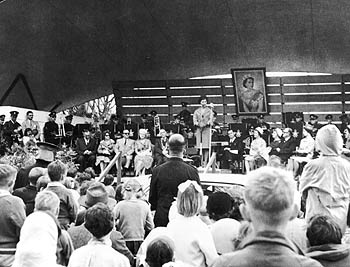 Queen
Elizabeth's portrait is prominent at this citizenship
ceremony in Cooma in the early 1960s. Photo: Bayram
Ali (Powerhouse Museum Collection)
Queen
Elizabeth's portrait is prominent at this citizenship
ceremony in Cooma in the early 1960s. Photo: Bayram
Ali (Powerhouse Museum Collection)
|
The photograph above shows a naturalisation ceremony
in Cooma in the early 1960s. The portrait of Queen Elizabeth
II is visible at the back of the stage. It also appeared
on naturalisation certificates. However, the woman addressing
the crowd is Tanya Verstak the first non-Anglo
Miss Australia. Her presence suggests a shift in attitudes
towards migrants and the acceptance of cultural diversity.
In 1959 the town of Cooma built an avenue of flags in
its main park to acknowledge the contribution of different
nationalities to the Scheme. An International Club was
established to celebrate different cultures and public
debates on the place of migrants in Australian society
were held.
Despite
the emphasis on assimilation, migrants did not abandon
their cultural practices and beliefs. Anti-communist
workers, from Balkan states in particular, frequently
removed the communist Yugoslav flag in the avenue of
flags. Attempts to reinstate the flag were eventually
abandoned.
|
This German carpenters' guild scarf was brought
to Australia by Karl Rieck. Like his colleagues,
Karl wore his traditional carpenter's costume
of black corduroy while working at Island Bend,
in deference to his native country's guild rules.
The German carpenters were among the most distinctive
groups on the Scheme.
Lutherans
established a congregation in Cooma and built
a church that continues to service their community.
Delicatessens and restaurants offering a range
of foods for the new European communities opened
in Cooma and Tumut where previously there had
been only traditional Anglo-Australian cuisine.
|
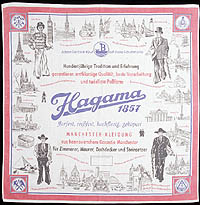
Photo: Sotha Bourn
(Powerhouse Museum Collection) |
Snowy
workers from Norway, Czechoslovakia, Italy and Germany
helped to develop the small Australian skiing industry.
Kore and Eva Grunnsund followed in the footsteps of
an earlier Norwegian immigrant, Martin Amundsen, who
introduced new skiing technologies and techniques to
Australia in the 1880s. Czechoslovakian born Tony Sponar
helped to establish Thredbo as a major tourist resort.
The photograph below shows a ski jump built at the authority
town of Cabramurra. The event is probably the NSW and
National Championships of 1961, which featured ski jumping,
slalom and langlauf (cross-country) events.
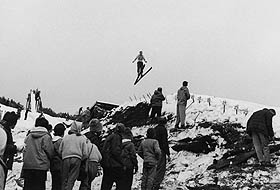
Photo: Bayram Ali (Powerhouse Museum
Collection) |
|